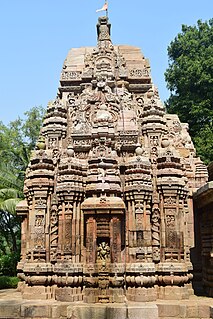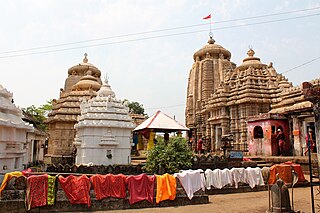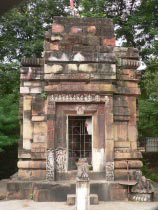
Baitāḷa deuḷa or Vaitāḷa deuḷa is an 8th-century Hindu temple of the typical Khakara style of the Kalinga architecture dedicated to Goddess Chamunda located in Bhubaneswar, the capital city of Odisha, India. It is also locally known as Tini-mundia deula due to the three spires on top of it, a very distinct and unusual feature. The three spires are believed to represent the three powers of the goddess Chamunda - Mahasaraswati, Mahalakshmi and Mahakali.

Barahi Deula is an ancient 9th century built temple situated on the eastern coast of Odisha in Puri district,India. The barahi temple of Chaurasi is unique in more than one way. The image enshrined in this temple is considered to be one of the masterpieces among the images of the deity found all over India.

Jalesvara Siva Temple Precinct is a Hindu Temple dedicated to Shiva situated on the southern outskirt of the village Kalarahanga at a distance of 2.00 km from Patia and 6.00 km south of Chudangagada in the northern outskirt of Bhubaneswar, Odisha, India. The presiding deity is a Siva-lingam within a circular yonipitha inside the sanctum, which is 1.15 meters below the chandrasila. The sanctum measures 2.00 square meters.

The Kapilesvara temple is a Hindu temple dedicated to Shiva located in the south western outskirt of the village Kapilesvara, Old Town, Bhubaneswar, Odisha, India. It is located at the end of Kapilesvara road leading from Lingaraj temple to Kapilesvara Village. The presiding deity is a Siva-lingam at the center of a circular yonipitha inside the sanctum. It is a living temple, facing towards east and maintained by Kapilesvara Temple Trust Board. The temple is situated within the precinct along with 33 other monuments. The precinct is located on the northern embankment of Manikarnika tank over an area of 44.00 square metres.

Nilakanthesvara Shiva Temple is a temple in Orissa, India, located on the western embankment of the Bindusagar tank. It is situated on the left side of the lane branching from the road leading from Kedar Gouri chowk to the Vaitaḷa deuḷa in Bhubaneswar, the capital state of Orissa. The temple faces east. The temple's enshrining deity is a circular yoni pitha with a chlorite Siva lingam. The temple is made out of sandstone. The present temple is a recent construction over the remains of an earlier one. The building material is old but the entire structure now has cement plaster and an enamel point.

Chintamaniswar Shiva Temple is a Hindu temple dedicated to Lord Shiva in Bhubaneswar, the capital of Odisha, India. It is at the end of the Chintamaniswar road branching from Cuttack-Puri road near the Old Station Bazar. The temple faces west and the enshrined deity is a Siva lingam with a yonipitha.

The Kukutesvara Siva Temple or Kukutesvara Temple is a small, 1000-year-old shrine to Shiva located in the "Temple City of India" Bhubaneswar, Orissa.
Bhandara Ghara Shrine is located in the Kapilesvara temple precinct. It is a living temple facing towards east. It enshrines the chalanti pratima of Visnu and Siva. These deities are taken on procession on various festive occasions for public viewing. It was built around 16th century A.D.

Siddhesvara Siva Temple is located inside the Kapilesvara temple precinct, Kapilesvara village, Old Town, Bhubaneswar. It was built in the 15th century AD. The temple is facing east and the presiding deity of the temple is a Siva lingam within a circular yonipitha, which is made of laterite. The cella of vimana is measuring 1.55 square m. The temple is made of sandstone and totally renovated one. It is under the care of Kapilesvara Temple Trust Board.

Nilakantha Siva temple is located in the Kharakhia Baidyanatha temple precinct, Kharakhia Vaidyanath Sahi, Old Town, Bhubaneswar. One can approach to this site on the left side of the Vaidyanath road leading from Lingaraja temple to Kapilesvara. This is a living temple and is facing towards the west. The enshrining deity of this temple is a Siva lingam within a circular yoni pitha at the centre of the sanctum sanatorium. The sanctum is 0.77 metres below the chandrasila.

The Somesvara Siva temple is located in the Kharakhia Baidyanath temple precinct in Kharakhia Vaidyanath Sahi, Old Town, of Bhubaneswar. It is located approximately 300 metres south of Lingaraja temple. Visitors may approach the site on the left side of Baidyanath Road leading from Lingaraja temple to Kapilesvar. It is a living temple and faces towards the west. The enshrined deity of this temple is a Siva lingam within a circular yonipitha at the center of the sanctuary located 0.93 metres below the chandrasila. The temple is under the care and maintenance of Babulal Makaddam Badu Mohapatra, the chief priest of the temple, on whose private land the temple stands.

Narasimha Temple is a 14th–15th-century temple in Bhubaneswar city of the state of Odisha, India. The time period of its construction is estimated from its architectural features. Its tradition and legends are same as the Gosagaresvara temple. It is situated in the precinct of Gosagaresvara on the southeastern side of Gosagaresvara Shiva and Paradaresvara Shiva temples. The presiding deity is a four armed Narasimha image seating on a pedestal. His upper left hand holding a conch, upper right hand holds a disk while in his major left and right hand are busy in killing the demon. The base of the pedestal is carved with series of females, in anjalii mudra. The cella measures 1.15 square metres and is facing towards west.

Gangesvara Siva Temple is situated within a precinct on the left side of the Ganges–Yamuna road Old Town, Bhubaneswar,Orissa,India. It is located at a distance of 200 metres north-east of Lingaraj temple, 50 metres north of Lakhesvara temple across the road, 200 metres south of Subarnesvara and 100 metres east of Gourisankar temple. The temple is facing towards east. The presiding deity is a Siva lingam within a circular yonipitha. It is a living temple and maintained by the Ganga YamunaSangathana.

Uttaresvara Siva Temple is a 12th-century Hindu temple dedicated to Lord Siva located in Bhubaneswar, Odisha, India.

The Talesvara Siva temple is a Hindu temple in Bhubaneswar, Odisha, India.

Sarvatresvar Siva Temple is situated on the right side of Mahavir lane branching from Lewis road to Sisupalgarh,Bhubaneswar,Orissa,India. It enshrines a Siva-lingam within a circular yonipitha inside the sanctum. It is a living temple and Bibhuti Bhusan Das is the chief priest of the temple. As per the chief priest it is a Patalaphuta linga. The temple precinct is located on the right bank of the stream Gangua.
iii) Tradition & legends: The name of the deity Sarvartesvara implies as the lord of all the planes.

Sinduresvara Siva temple is located in village Sundarpada, Old Town, Bhubaneswar, Odisha, India. It is on the right side of the road leading from Lingaraj temple to Sundarpada. The enshrined deity is a circular yonipitha facing towards the north. The Siva lingam decayed in course of time. In April 2013 the villagers raised funds and reestablished new Shiv Linga. There are two entrances on the south-west and northwest corners provided with seven flights of steps leading down to the temple.

Astasambhu Siva Temples is a collection of 8 Hindu temples dedicated to Lord Siva located in Bhubaneswar, the capital of Odisha, India.

Chakresvara Shiva temple is a living Hindu temple built in 10-11 AD dedicated to Lord Shiva at Hatiasuni lane, Rajarani Colony, Bhubaneswar of Odisha, India. The deity, lingam, is in a circular yonipitha inside the sanctum. The temple is surrounded by private residential buildings on its eastern and northern side and chakresvara tank in the west. It is of great significance as rituals like Shivaratri, Diwali, and Sankranti are observed here. Also this temple serves as a purpose of a sacred place for 'Thread Ceremony, Rudrabhiseka, Chandrabhiseka.'

Kalyanasundara, also spelt as Kalyansundar and Kalyana Sundara, and known as Kalyanasundara-murti, Vaivahika-murti and Panigrahana-murti ( पाणिंग्रहण-मूर्ति), is the iconographical depiction of the wedding of the Hindu deities Shiva and Parvati. The couple are often depicted performing the panigrahana ritual of a Hindu wedding, where the groom accepts the bride by taking her right hand in his.










